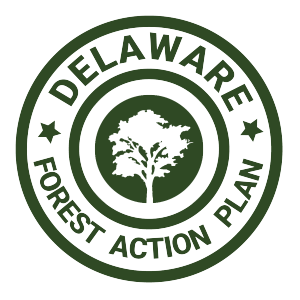Sunday hunting is prohibited on all State Forest property More Info
 Delaware’s Forest Action Plan consists of two major documents: a comprehensive forest resource assessment and a statewide forest strategy. The plan is submitted to the U.S. Forest Service every ten years as part of a comprehensive process that involves staff, governmental partners at all levels, and important stakeholders including private landowners, industry groups, nonprofits, natural resource agencies, and the general public.
Delaware’s Forest Action Plan consists of two major documents: a comprehensive forest resource assessment and a statewide forest strategy. The plan is submitted to the U.S. Forest Service every ten years as part of a comprehensive process that involves staff, governmental partners at all levels, and important stakeholders including private landowners, industry groups, nonprofits, natural resource agencies, and the general public.
The final version of the 2020 Delaware Forest Resource Assessment (in flip book and PDF format) is now available for public review. It marks a 10-year update of the 2010 Delaware Forest Resource Assessment (link). It follows the same seven criteria and eighteen indicators as outlined in the Montréal Process and adopted by the Northeast-Midwest State Foresters Alliance. All aspects, both biological and social, of forests and their sound management are addressed. These include biological diversity, productive capacity, forest health, soil and water resources, carbon cycles, social aspects, and legal and economic issues. Each criterion is supported by at least one corresponding indicator.

The 2020 Delaware Statewide Forest Strategy includes performance goals and action items that when enacted will help ensure the health of urban and rural forests for years to come. The assessment was completed under the guidance of the Delaware Forest Stewardship Committee and with input from many other stakeholders. It identifies the most current priority issues, threats, and opportunities regarding Delaware’s forest resource. Additionally, priority urban and rural landscapes were identified in the assessment. A summary of the resource assessment is presented below but the entire document is available at this link.
The DFS worked closely with a variety of stakeholders and conservation-minded organizations and concluded that the four overriding state issues developed for the 2010 Delaware Forest Action Plan were still relevant today. The corresponding 19 comprehensive, long-term strategies were also retained but modified and updated where necessary and three new strategies were added. Each strategy contains multiple action items with performance goals to measure success. All previous 78 action items were also reviewed and updated. Participants in the review process made suggestions for additional performance goals related to the updated forest resource assessment. Twenty-seven new performance goals are included in this update. These were incorporated into the final strategy as well. Many of the action items will require years, if not decades, to achieve and also require partnering with one or more public and/or private organizations to accomplish. Nonetheless, we believe this updated strategy document is an excellent guide for the DFS to focus limited resources on the key issues facing Delaware’s forests.